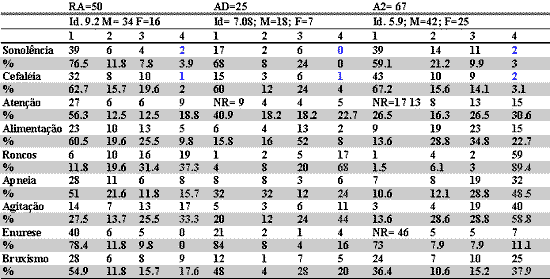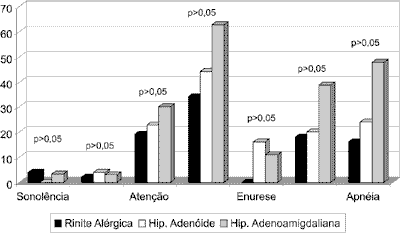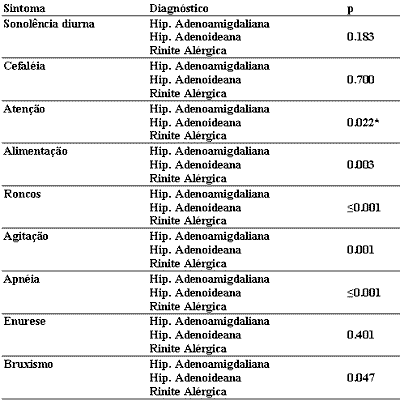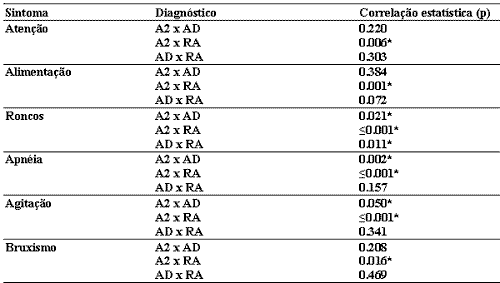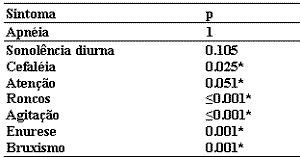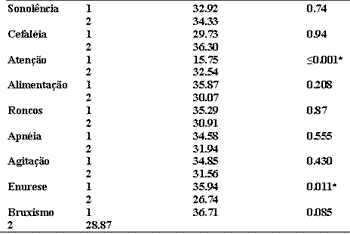

Year: 2004 Vol. 70 Ed. 5 - (13º)
Artigo Original
Pages: 665 to 670
Mouth breathing in children: different effects according to diagnosis
Author(s):
Renata C. Di Francesco1,
Gustavo Passerotii2,
Bruno Paulucci3,
Aroldo Miniti4
Keywords: mouth breathing, child, adenoid, tonsil, rhinitis.
Abstract:
Introduction: Mouth breathing is very common in children. Mouthbreathing syndrome is characterized by tiredness, daytime sleepiness, failure to thrive, restless sleep, nocturnal enuresis and poor school performance. However, this symptom has several causes and it is necessary to elucidate more details about this entity. Objective: Compare the findings of daytime sleepiness, headache, nocturnal enuresis, poor school performance and attention deficit and bruxism in subjects that present mouth breathing according to the following diagnosis: allergic rhinitis, adenoidal hyperplasia and adenotonsillar hyperplasia. Material and Methods: This is a prospective study of 142 patients from 2 to 16 years old. After ENT evaluation, patients were classified in 3 groups according to the following diagnosis: allergic rhinitis, adenoidal hyperplasia, adenotonsillar hyperplasia. Parents and caregivers answered a questionnaire about night symptoms in order to describe the presence of sleep apnea and specific questions about: morning headaches, school performance and attention deficit, daytime sleepiness, restless sleep, nocturnal enuresis and bruxism. Results: Mouth breathing is common in boys. Children with adenotonsillar hyperplasia are younger and present more snoring and sleep apnea. They present also poor school performance, bruxism, nocturnal enuresis and restless sleep, which are correlated to sleep apnea, differing from the allergic rhinitis group. Significant findings of daytime sleepiness and morning headaches were not found. Conclusion: Bruxism, enuresis, restless sleep and poor school performance are related to sleep apnea and more frequent in subjects with adenotonsillar hyperplasia. The investigation of sleep apnea in children with mouth breathing is mandatory, as well as the determination of its cause.
![]()
Introduction
Mouth breathing is one of the most frequent symptoms in children. There are many causes for this condition, which is usually called Mouth Breather Syndrome. Respiratory disorders may vary from simple allergic processes to more intense states, such as sleep apnea1.
There are several etiological factors for mouth breathing, among which we may emphasize the following: adenotonsillar hyperplasia, allergic and non-allergic rhinitis, and hypertrophy of lower turbinates, etc.2; allergic rhinitis is the most frequent symptom3.
Many physical characteristics are attributed to these patients and the most relevant are alterations of the dental-craniofacial skeleton, which were described in the 19th century. Children with persistent mouth breathing present facial alterations, such as vertical enhancement of the facial inferior third, narrow maxillary arch, high-roof palate, obtuse goniac angle, dental malocclusion (open bite, protruded superior incisors, cross bite), low hyoid bone and short upper lip, everted inferior lip, labial incompetence, jaw elevators' hypotony, lingual hypotony, tongue alterations at rest, swallowing and speech affections, bite and vocal disorders, as well as postural changes6.
The symptoms frequently reported by some authors in reference to mouth breathing children are constant fatigue, daytime fatigue, lack of dynamism, lack of appetite, night enuresis, and even learning deficit7. There are only a few original articles on the above, while most are statements excerpted from anecdotic citations or literature reviews7.
Taking into account that it is a multiple factorial syndrome associated with several other pathologies, it is mandatory to better understand the clinical aspects of this entity.
Objective
This article aims at analyzing findings such as daytime sleepiness, headache, nocturnal restlessness, school difficulties/lack of attention and bruxism in children in the 2-14 years age range with history of oral breathing and considering 3 diagnosis: allergic rhinitis, adenoidal hyperplasia, adenotonsillar hyperplasia.
Material and Methods
The present prospective study was conducted from April 2001 to December 2002 with 142 patients of both sexes aged 2-14 years admitted to the Ambulatory of Otorhinolaryngology, Hospital das Clínicas, University of Sao Paulo.
Patients were distributed among 3 groups according to the following diagnoses: allergic rhinitis, single adenoidal hyperplasia and adenotonsillar hyperplasia.
In order to be included in the allergic rhinitis group, the patient must have presented pertinent symptoms and signs as well as typical clinical examination and positive result for cutaneous hypersensitivity. For the adenoidal hyperplasia group, patients with nasopharyngeal obstruction higher than 80% and determined by profile teleradiography were included. The adenotonsillar hyperplasia group considered patients with pharyngeal tonsil and oropharyngeal obstruction by Brodsky grades 3 and 4 of palatine tonsils8. Patients with craniofacial deformities, as well as neurological syndromes and disorders were excluded.
All patients' parents/caregivers filled in a standard questionnaire (see attachment) over nocturnal symptoms in search for the presence or absence of sleep apnea, besides specific questions on the following aspects: daytime headache, school performance and attention, daytime sleepiness, restless sleep, enuresis and bruxism.
The study was approved by the Ethics Committee of Hospital das Clínicas, Medical School, USP and parents/caregivers signed the informed consent to participate in the trial.
Results
The trial included 142 patients, with ages ranging from 2 to 14 years (mean age 7.2±3.77), out of which 92 were males and 50 females. According to race, patients were distributed among 90 Caucasian, 7 African-descendents and 45 Brazilian native pardos. Patients were classified according to their diagnoses (Table 1).
A comparative analysis between the age range averages for each diagnosis group is shown in Table 2.
According to Table 3, a progressive increase in the frequency of snoring among the 3 groups is observed, which is lower in the allergic rhinitis group and much higher in the adenotonsillar hyperplasia one, the same occurring in the presence of apnea. Table 3 also describes the frequency of other studied symptoms, according to the classification established by the authors.
Graph 1 shows the comparison of each disease's characteristics, considering grade 4 presented in Table 3 as the major one.
Concerning the attention deficit referred to as grade 4 for bad school performance, a higher frequency was observed in the group of adenotonsilar hyperplasia, while symptoms of nocturnal restlessness, enuresis and bruxism have proven to be statistically more often in the same group. Association with a higher frequency of sleep apnea has been reported.
Table 4 shows distinct symptoms and features of each diagnosis group. Significant differences may be noticed, particularly in aspects such as attention deficit, excessive snoring, restlessness, apnea and bruxism.
Comparing the 3 groups' symptoms, on a two-to-two basis, striking differences between the adenotonsillar hyperplasia group and the allergic rhinitis one are observed for the majority of symptoms, as well as between the single adenoidal hyperplasia group and the adenotonsillar hyperplasia one for snoring, restlessness and apnea (Table 5).
Table 6 reveals that headache, attention deficit, enuresis, restlessness and bruxism are dependent on apnea. No differences are observed between symptoms and age, when both groups are compared according to the mean age, except for enuresis and attention deficit (Table 7).
Discussion
Respiratory disorders are very frequent in children, varying from allergic processes up to more intense conditions, such as sleep apnea1.
In our sample, we could verify a predominance of boys, which is consistent with other authors, not only in frequency of mouth breathing9, but also in relation to sleep apnea resulting from adenotonsillar hyperplasia, a condition most often observed in males10.
Comparing the mean age of the 3 groups, children with adenotonsillar hyperplasia were younger than those with allergic rhinitis and this is due to different incidence peaks of both diseases. Allergic rhinopathy affects children at any age11, although it is usually late diagnosed due to its milder symptoms, whereas adenotonsillar hyperplasia's higher incidence occurs between 3 and 6 years of age12.
Considering that these symptoms are the most common ones, sleep respiratory disorders in children may be diagnosed late - sometimes only after 2 years13.
Several characteristics relative to mouth breathing patients are reported. However, it is known that mouth breathing is a symptom and, many times, it is even considered a syndrome called Mouth Breather Syndrome. We all recognize that there are many causes for mouth breathing, which are varied diseases with very distinct pathophysiologies. Therefore, compiling all mouth breathers within a homogeneous group is a very difficult task.
This research study enabled us to verify that many of the characteristics attributed to mouth breather could be limited to sleep apnea patients. Investigation on sleep apnea in mouth breathing children is mandatory, since this disease presents potential complications, which are not so commonly observed in allergic rhinitis patients.
A thorough questionnaire focused on sleep characterization and disorders, as well as on the presence of apnea is fundamental. Similarly to other authors, we came to the conclusion that this method may often limit or substitute polysomnography 14.
Sleep apnea is broadly diversified among children and not always a reliable diagnosis is achieved in the sleep laboratory, added to the fact that the high cost is extremely discouraging. Clinical history of sleep apnea is highly sensitive for patients' screening14.
Snoring and apnea were predominant symptoms in adenotonsillar hyperplasia patients, which corroborates with the relevant literature that refers this condition as the main cause of sleep respiratory disorders during childhood12.
Differently from the allergic rhinopathy and adenoidal hyperplasia groups, this case of apnea is related to hypopharyngeal obstruction. Hypopharyngeal patency is determined both by anatomical and physiological factors. During the inhaling process, a negative intraluminal pressure (subatmospheric) occurs, occasionally leading to pharyngeal collapse. Thus, any factor that reduces the pharyngeal lumen or increases its compliance may predispose a subject to sleep apnea15.
The frequencies of day sleepiness and headache were similar in both groups. Comparing the occurrence of apnea in adults, it was expected that daytime sleepiness and headache would be more frequent in the adenotonsillar hyperplasia group. However, differently from frequent apnea episodes in adults, it is reported that partial obstructive hypoventilation - characterized by snoring, thoracic paradoxical movement, oxy-hemoglobin phasic desaturation and hypercarpnia - would justify the low incidence of daytime sleepiness and headache in children15.
Attention deficit and bad school performance were also prevalent in the group of hyperplasia of the pharyngeal and palatine tonsils associated with apnea. Low blood levels during sleep, as well as at awakening, occur in the REM phase (Rapid Eyes Movement) and such sleep fragmentation is responsible for these symptoms 12. It seems that this fragmentation prevents stimulation of cognitive centers during brain growth 16. However, it is important to emphasize that allergic rhinopathy patients may also present cognitive deficits. In these cases, they are related to traditional anti-histaminic drugs that penetrate the blood-brain barrier causing sleepiness17.
At last, due to apnea and sleep fragmentation, higher frequency of nocturnal restlessness, bruxism and enuresis was observed in the adenotonsillar hyperplasia group. Nocturnal restlessness - as well as bruxism - results from the increase of muscular tonus and emerging lower limb movements. These conditions improve with adenotonsillectomy, when apnea is also treated18.
Nocturnal enuresis is improved with adenotonsillectomy due to sleep architecture alterations, once reduced secretion of antidiuretic hormone or increased atrial natriuretic peptide levels lead to higher urinary volume19.
In a comparative analysis between symptoms and age groups (based on the mean ages of each group), it was noticed that there were no significant differences between the younger and the older groups in what symptoms were concerned, except for nocturnal enuresis and learning deficit. These findings were not significant, considering that patients age ranges in this study were very broad, presenting very young children with expected night enuresis, who are not attending school and whose school deficit analysis is unfeasible.
Conclusions
The study came to the conclusion that bruxism, enuresis, nocturnal restlessness and headache are related to sleep apnea, most frequently found in adenotonsillar hyperplasia. Daytime sleepiness and morning headache are not so frequent in mouth breathing children, even in those with sleep apnea. Therefore, investigation on sleep apnea in mouth breathing children is crucial, as well as on the cause of oral breathing, considering that very distinct effects could be observed.
References
1. Wald ER. Rhinitis and acute and chronic sinusitis. In: Blustone CD, Stool SE, Kenna M. Pediatric Otolaryngology. Philadelphia: Saunders; 1996. 1: 1843-58.
2. Di Francesco RC. Respiração bucal. A visão do otorinolaringologista. Jornal Brasileiro de Fonoaudiologia 1999; 1 (1): 56-60.
3. Stokes N, Mattia DD. A student research review of the mouth breathing habit: discussing measurements methods, manifestations and treatment of the mouth breathing habit. Probe 1996; 30: 212-4.
4. Mocellin, M. Alterações esqueléticas decorrentes da respiração bucal. São Paulo, 1986, 72p. Tese (Doutorado). Escola Paulista de Medicina.
5. Trask G, Shapiro P. The effects of perennial rhinitis on dental and skeletal development: A comparison of sibling pairs. Am J Orthod Dentof Orthop 1987; 92: 286-93.
6. Bresolin D et al. Mouth breathing in allergic children: Its relationship to dentofacial development. Am J Orthod 1983; 83: 334-40.
7. Aragão W. Respirador bucal. Jornal de Pediatria 1988; 63: 349-52.
8. Brodsky L. Tonsillitis, tonsillectomy and adenoidectomy. In: Bailey BJ. Ed. Head and Neck Surgery - Otolaryngology. Philadelphia: JB Lippincott; 1993; 838-47.
9. Kellum GD, Gross AM, Walker M, Foster M, Franz D, Michas C, Bishop FW. Open mouth posture and cross sectional nasal area in young children. Int J Orofacial Myology 1993; 19: 25-8.
10. Rosen CL. Obstructive sleep apnea syndrome (OSAS) in children: diagnostic challenges. Sleep 1996; 19 (10) S274-7.
11. Castro F. Rinite Alérgica. Novas abordagens para uma questão antiga. São Paulo: Vivaldi; 1997.
12. Poodle MD, Pereira KS. Pediatric sleep disordered breathing. In: Bailey BJ. Head and Neck Surgery - Otolaryngology. Philadelphia: J.B. Lippincott Company; 2001. Available at http://www.ovid.com/books.
13. American Academy of Otolaryngology Head and Neck Surgery; 2003.
14. Goldstein NA, Scurelati N, Walsleben JA, Bhatia N, Friedman D, Rapoport DM. Clinical diagnosis of pediatric obstructive sleep apnea validated by polysomnography. Otolaryngology Head and Neck Surg 1994; 111(5); 611-7.
15. Brooks LJ. Diagnosis and pathophysiology of obstructive sleep apnea in children. ENT Journal 1993; 72 (1) 58-60.
16. Gozal D, Pope D. Snoring during early childhood and academic performance at ages thirteen to fourteen. Am Acad Pediatrics 2001; 107(6): 1394-99.
17. Balbani APS, Caniello M, Myake MAM, MelloJR JF, Butugan O. Rinites e anti-histamínicos: impacto na cognição e psicomotricidade. Rev Bras Alerg Imunopatolol 2001; 24: 106-14.
18. Di Francesco RC, Junqueira PA, Trezza P, Faria ME, Frizaarini R, Zerati F. Improvement of bruxism after T&A surgery. Int J Pediatr Otolaryngol. No prelo.
19. Robson WL, Leung AKC. Secondary nocturnal enuresis. Clinical pediatrics 2000; 39(7): 379-85.Table 1. Distribution by diagnosisTable 2. Mean ages and diagnosisTable 3. Comparative analysis between characteristics and diagnosis
AR= Allergic Rhinitis; AD= Adenoid hyperplasia; A2= Adenotonsillar hyperplasia
NR= Non-respondent
Note: those who do not attend school did not respond
Sleepiness: those who are still sleepy in the afternoon did not respond
Enuresis: those who still use dippers did not respond
Graph 1. Comparative analysis between each disease's characteristicsTable 4. Correlation between diagnosis and symptoms
Significant when p?0.050
Kruskal-Wallis TestTable 5. Correlation of symptoms and diagnoses
Mann-Whitney Test for pairs of groups p?0.050Table 6. Correlation between apnea and other symptoms
Spearman Test of non-parametric correlation of p?0.050Table 7. Comparison between age ranges distributed by mean age and symptoms:
Group 1- below 7 years old
Group 2 - above 7 years old


